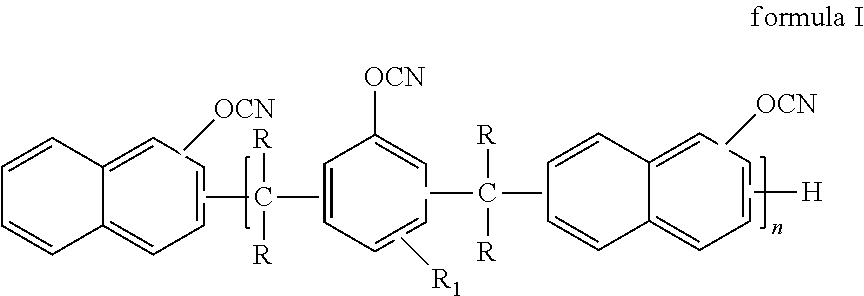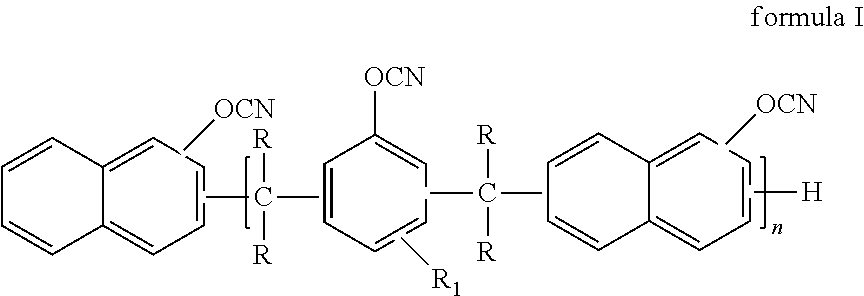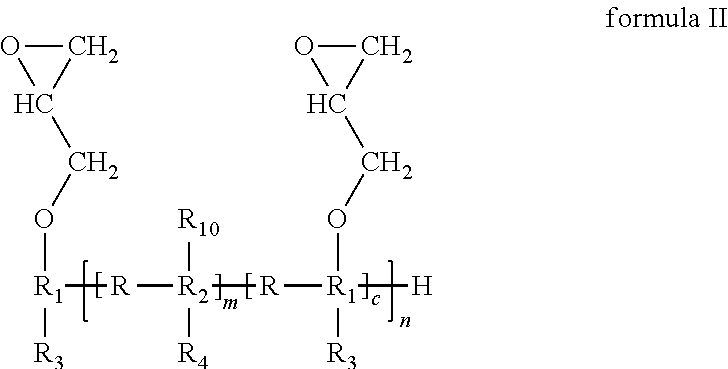Cyanate ester resin composition, and a prepreg, a laminated material and a metal clad laminated material made therefrom
- Summary
- Abstract
- Description
- Claims
- Application Information
AI Technical Summary
Benefits of technology
Problems solved by technology
Method used
Image
Examples
synthetic example 1
[0059]Add 300 g of chloroform and 0.98 mol of cyanogen chloride into a three-neck flask, stir fully to make them mix evenly, and stabilize the temperature at −10° C. Dissolve 67 g of (hydroxy content is 0.50 mol) naphthol phenol novolac resin (provided by Nippon Kayaku Co., Ltd., the structural formula is as shown in the following formula VI) and 0.74 mol of triethylamine in 700 g of chloroform, make them mix evenly, add the solution in drops at −10° C. slowly into the above mentioned solution of cyanogen chloride in chloroform, and make the dropping time longer than 120 min. After finish dropping, continue to react for 3 hours, and then stop the reaction. Use a funnel to filter out the salt produced in the reaction, wash the filtrate obtained with 500 ml of 0.1 mol / L hydrochloric acid, and then wash with deionized water for five times until the PH value is neutral. Add sodium sulfate to the extracted chloroform solution, so as to remove the
synthetic example 2
[0060]Except for 67 g of (hydroxy content is 0.50 mol) naphthol phenol novolac resin used in the synthetic example 1 being replaced with naphthol phenol novolac resin with hydroxy content of 0.50 mol (provided by MEIWA PLASTIC INDUSTRIES, LTD., the structural formula is as shown in the following formula VIII), naphthol phenol novolac type cyanate ester resin is obtained by the same method as according to the synthetic example 1, of which the structural formula is as shown in the following formula IX.
embodiment 1
[0061]Dissolve 65 parts by weight of naphthol phenol novolac type cyanate ester resin obtained in the synthetic example 2, 35 parts by weight of naphthol naphthyl ether type epoxy resin (EXA-7311, provided by DIC Co., Ltd.) and 0.02 parts by weight of zinc caprylate in methyl ethyl ketone, make them mix evenly, then add 125 parts by weight of boehmite (APYRAL AOH 30, provided by to Nabaltec), 25 parts by weight of spherical fused silica (SC2050, provided by
[0062]Admatechs), 5 parts by weight of organic silicon powder (KIP-605, provided by Shin-Etsu Chemical Co., Ltd.), 1 parts by weight of epoxy group silane coupling agent (Z-6040, provided by Dow Coming Corporation), 1 parts by weight of dispersing agent (BYK-W903, provided by BYK) and add methyl ethyl ketone to adjust to an appropriate viscosity, and then stir and mix evenly to obtain a glue solution. Impregnate 1078 fiberglass cloth, 2116 fiberglass cloth with the above mentioned glue solution, then dry the fiberglass cloth to re...
PUM
| Property | Measurement | Unit |
|---|---|---|
| Percent by mass | aaaaa | aaaaa |
| Percent by mass | aaaaa | aaaaa |
| Weight | aaaaa | aaaaa |
Abstract
Description
Claims
Application Information
 Login to View More
Login to View More - R&D
- Intellectual Property
- Life Sciences
- Materials
- Tech Scout
- Unparalleled Data Quality
- Higher Quality Content
- 60% Fewer Hallucinations
Browse by: Latest US Patents, China's latest patents, Technical Efficacy Thesaurus, Application Domain, Technology Topic, Popular Technical Reports.
© 2025 PatSnap. All rights reserved.Legal|Privacy policy|Modern Slavery Act Transparency Statement|Sitemap|About US| Contact US: help@patsnap.com



